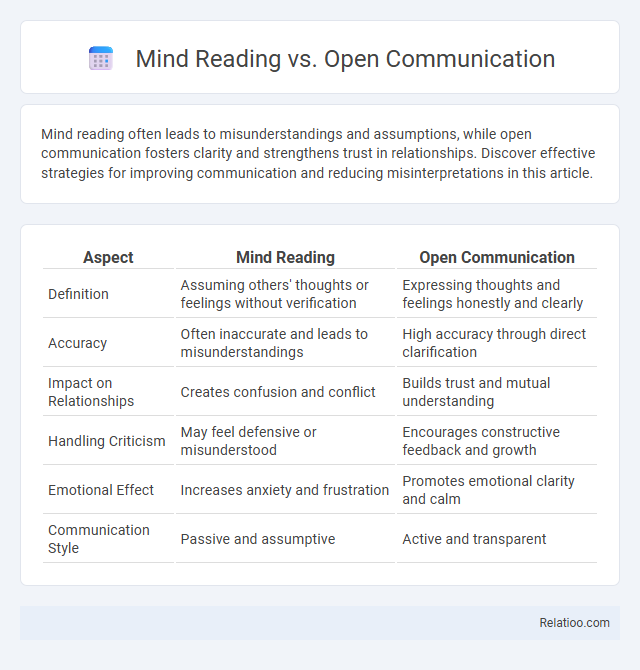Mind reading often leads to misunderstandings and assumptions, while open communication fosters clarity and strengthens trust in relationships. Discover effective strategies for improving communication and reducing misinterpretations in this article.
Table of Comparison
| Aspect | Mind Reading | Open Communication |
|---|---|---|
| Definition | Assuming others' thoughts or feelings without verification | Expressing thoughts and feelings honestly and clearly |
| Accuracy | Often inaccurate and leads to misunderstandings | High accuracy through direct clarification |
| Impact on Relationships | Creates confusion and conflict | Builds trust and mutual understanding |
| Handling Criticism | May feel defensive or misunderstood | Encourages constructive feedback and growth |
| Emotional Effect | Increases anxiety and frustration | Promotes emotional clarity and calm |
| Communication Style | Passive and assumptive | Active and transparent |
Understanding Mind Reading: Definition and Misconceptions
Mind reading involves assuming you know what others think or feel without concrete evidence, often leading to misunderstandings and conflicts. Open communication encourages expressing thoughts and feelings directly to clarify intentions and prevent false assumptions. Understanding the misconceptions around mind reading helps you recognize cognitive distortions and promotes healthier interpersonal interactions.
The Psychology Behind Mind Reading in Relationships
Mind reading in relationships occurs when you assume you know your partner's thoughts or feelings without explicit communication, often fueled by cognitive distortions like jumping to conclusions or emotional reasoning. This psychological tendency can create misunderstandings and emotional distance, as it replaces open communication with inaccurate assumptions. Cultivating awareness of these automatic thought patterns helps improve connection by encouraging direct dialogue and reducing misinterpretations.
Open Communication: Core Principles and Benefits
Open communication fosters clarity and trust by encouraging honesty, active listening, and transparency between individuals, which reduces misunderstandings caused by assumptions such as mind reading or cognitive distortions. It promotes emotional intelligence and empathy, enabling participants to express thoughts and feelings openly, leading to stronger relationships and collaborative problem-solving. Consistent practice of open communication can mitigate cognitive distortions by aligning perceptions with reality and improving conflict resolution outcomes.
Mind Reading vs Open Communication: Key Differences
Mind reading involves assuming others' thoughts or intentions without verification, often leading to misunderstandings and negative emotions. Open communication emphasizes clear, direct expression and active listening, fostering mutual understanding and trust. Unlike mind reading, open communication reduces assumptions and cognitive distortions by encouraging transparent exchanges of thoughts and feelings.
Common Pitfalls of Relying on Mind Reading
Relying on mind reading often leads to misunderstandings because assumptions about others' thoughts are rarely accurate, creating unnecessary conflict and anxiety. Open communication prevents these pitfalls by encouraging direct dialogue, allowing your intentions and feelings to be clearly expressed and understood. Cognitive distortion can reinforce mind reading tendencies by twisting perceptions into false conclusions, limiting your ability to view interactions realistically and constructively.
Signs You’re Engaging in Mind Reading
Signs you're engaging in mind reading include assuming others' thoughts or intentions without verification, often leading to misinterpretations and unnecessary conflict. This cognitive distortion blurs reality by replacing open communication with false assumptions, resulting in increased anxiety and damaged relationships. Recognizing these signs prompts healthier dialogue and reduces misunderstandings.
How Open Communication Prevents Conflicts
Open communication ensures clarity by encouraging individuals to express thoughts and feelings directly, reducing the risk of misunderstandings often caused by mind reading assumptions. By fostering an environment where your intentions and expectations are clearly conveyed, open communication counters cognitive distortions such as jumping to conclusions or negative bias. This proactive approach minimizes conflicts by creating mutual understanding and trust between parties.
Strategies to Shift from Mind Reading to Open Communication
Shifting from mind reading to open communication involves recognizing cognitive distortions that lead to assuming others' thoughts without evidence. Implementing strategies such as asking clarifying questions and expressing personal feelings fosters transparent dialogue and reduces misunderstandings. Building awareness of automatic negative assumptions enables individuals to address thoughts constructively rather than relying on inaccurate interpretations.
Real-Life Scenarios: Outcomes of Both Approaches
Mind reading often leads to misunderstandings and conflicts as individuals assume others' thoughts without verification, resulting in miscommunication and emotional distress. Open communication fosters clarity and trust by encouraging honest dialogue, which promotes problem-solving and strengthens relationships in real-life scenarios. Cognitive distortions, such as catastrophizing or black-and-white thinking, exacerbate negative outcomes by skewing reality, whereas addressing these distortions through open communication improves emotional regulation and interpersonal effectiveness.
Building Healthy Relationships Through Clear Communication
Building healthy relationships relies on distinguishing mind reading from open communication, as mind reading assumes intentions without verification, often leading to misunderstandings. Your ability to express thoughts and feelings clearly minimizes cognitive distortions--such as overgeneralization or catastrophizing--that can skew perception and hinder connection. Emphasizing transparent dialogue fosters trust, ensuring both parties feel heard and understood.

Infographic: Mind Reading vs Open Communication
 relatioo.com
relatioo.com